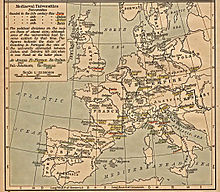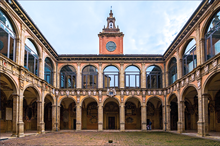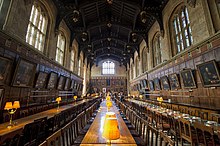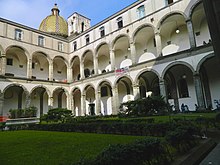Daftar universitas tertua dalam operasi berkelanjutan
Ini adalah daftar universitas tertua dalam operasional berkelanjutan di dunia.





Pencantuman dalam daftar ini ditentukan oleh tanggal lembaga pendidikan tersebut pertama kali memenuhi definisi tradisional universitas yang digunakan oleh sejarawan akademis[note 1] meskipun lembaga tersebut mungkin sudah ada sebagai lembaga yang berbeda sebelum waktu tersebut.[4] Definisi ini membatasi istilah "universitas" pada institusi-institusi dengan ciri-ciri struktural dan hukum khas yang berkembang di Eropa, dan yang menjadikan bentuk universitas berbeda dari institusi-institusi pendidikan tinggi lainnya di dunia pra-modern, meskipun hal ini kadang-kadang sekarang lebih populer disebut sebagai "universitas".
Untuk masuk dalam daftar, universitas tersebut harus sudah didirikan sebelum tahun 1500 di Eropa atau menjadi universitas tertua yang berasal dari model Eropa abad pertengahan di suatu negara atau wilayah. Lembaga ini juga harus tetap beroperasi, dengan kesinambungan kelembagaan tetap dipertahankan sepanjang sejarahnya. Jadi beberapa universitas awal, termasuk Universitas Paris, yang didirikan sekitar awal abad ke-13[5] tetapi dihapuskan oleh Revolusi Perancis pada tahun 1793,[6] tidak diinklusikan dalam daftar ini. Beberapa institusi muncul kembali, tetapi dengan fondasi baru, seperti Universitas Paris modern, yang berdiri pada tahun 1896 setelah Undang-Undang Louis Liard membubarkan sistem Universitas Prancis milik Napoleon.
Kata "universitas" berasal dari bahasa Latin universitas magistrorum et scholarium, yang kira-kira berarti "komunitas guru dan cendekiawan". Universitas Bologna di Bologna, Italia, tempat pengajaran dimulai sekitar tahun 1088 dan diorganisasikan menjadi sebuah universitas pada akhir abad ke-12, adalah universitas tertua di dunia yang terus beroperasi hingga saat ini,[1] dan universitas pertama dalam artian lembaga perguruan yang lebih tinggi, lembaga pembelajaran, dan lembaga pemberi gelar.[7][8][1] Asal usul banyak universitas abad pertengahan dapat ditelusuri kembali ke sekolah katedral Katolik atau sekolah biara, yang muncul pada awal abad ke-6 dan dijalankan selama ratusan tahun sebelum pendirian resminya sebagai universitas pada periode puncak abad pertengahan.[9]
Institusi pendidikan tinggi kuno, seperti Yunani kuno, Afrika, Persia kuno, Romawi kuno, Bizantium, Tiongkok kuno, India kuno, dan dunia Islam, tidak termasuk dalam daftar ini karena perbedaan budaya, sejarah, struktural, dan hukum dari universitas Eropa abad pertengahan, yang menjadi asal muasal universitas modern.[note 2][note 3][12] Universitas ini termasuk Universitas Al-Qarawiyyin dan Universitas Al-Azhar, yang masing-masing didirikan sebagai masjid pada tahun 857 dan 970 dan berkembang menjadi madrasah sebelum berdirinya universitas mana pun di Eropa, menjadikannya institusi pendidikan tinggi tertua yang terus beroperasi di dunia. Keduanya menjadi universitas dalam definisi modern masing-masing pada tahun 1963 dan 1961.
Asal usul abad pertengahan
Universitas sebagai sebuah institusi secara historis berakar pada masyarakat abad pertengahan, yang pada gilirannya mempengaruhi dan membentuknya. Sejarawan akademis Walter Rüegg menegaskan bahwa:[12]
Universitas adalah institusi Eropa; memang, ini adalah institusi Eropa par excellence. Ada berbagai alasan atas pernyataan ini. Sebagai komunitas guru dan pengajar, yang diberikan hak-hak tertentu, seperti otonomi administratif dan penentuan serta realisasi kurikulum (program studi) dan tujuan penelitian serta pemberian gelar yang diakui publik, ini adalah ciptaan abad pertengahan. Eropa, yang merupakan Eropa Kekristenan kepausan [...].
Penyebaran modern
Sejak awal periode modern dan seterusnya, universitas ini menyebar dari Barat Latin abad pertengahan ke seluruh dunia, akhirnya menggantikan semua institusi pendidikan tinggi lainnya dan menjadi institusi pendidikan tinggi terkemuka di mana pun. Prosesnya terjadi dalam urutan kronologis berikut:[13]
- Eropa Selatan dan Barat (dari abad ke-11 atau ke-12)
- Eropa Tengah dan Utara (dari abad ke-14 atau ke-15)
- Amerika (dari abad ke-16)
- Australia (dari abad ke-19)
- Asia dan Afrika (dari abad ke-19 atau ke-20), kecuali Filipina, dimana Universitas Santo Tomas didirikan pada abad ke-17.
Ditemukan sebagai universitas sebelum tahun 1500
Daftar ini mencakup universitas-universitas abad pertengahan yang didirikan sebelum tahun 1500 dan yang masih mempertahankan kesinambungan institusional sejak saat itu (tidak hanya universitas-universitas yang sudah tidak ada lagi, tetapi juga universitas-universitas yang bergabung atau memisahkan diri ke dalam institusi yang dianggap baru didirikan). Beberapa di antaranya telah ditutup untuk jangka waktu singkat: misalnya Universitas Siena ditutup pada tahun 1805–1815 selama perang Napoleon, dan universitas di Republik Ceko dan Polandia yang ditutup selama pendudukan Nazi, tahun 1938–1945.
Universitas berasal dari saat, menurut para sarjana, mereka pertama kali bertemu dengan definisi universitas. Dalam kasus seperti universitas Bologna dan Oxford yang menelusuri sejarahnya kembali ke pengajaran di masing-masing sekolah sebelum pembentukannya menjadi universitas, atau yang sudah ada dalam bentuk lain sebelum menjadi universitas, sehingga tanggal dalam daftar di bawah ini adalah tanggal setelahnya yang diberikan oleh lembaga untuk pendiriannya.[14]
| Tahun | Universitas | Lokasi | Catatan | |
|---|---|---|---|---|
| Dibentuk di | Sekarang bagian dari | |||
| 1180–1190[15] (pengajaran dari c. 1088) | Universitas Bologna |  Kerajaan Italia, Kerajaan Italia, Kekaisaran Romawi Suci Kekaisaran Romawi Suci |  Bologna, Italia Bologna, Italia | Sekolah hukum ada di Bologna sejak paruh kedua abad ke-12, dengan tahun 1088 sering dianggap sebagai tanggal dimulainya pengajaran di luar sekolah gerejawi.[16] Pada tahun 1158, petisi para doktor hukum Bolognese membuat Kaisar Barbarossa memberikan Habita Otentik, yang memberikan berbagai hak kepada pelajar dan magister tetapi tidak menyebutkan nama Bologna atau tempat belajar tertentu lainnya.[17] Namun, kecil kemungkinannya bahwa universitas tersebut telah terorganisir pada tahun 1150-an, dan ini mungkin terjadi pada akhir tahun 1180-an.[18] Sekolah hukum tampaknya tetap independen, merupakan entitas swasta hingga sekitar tahun 1180, namun menjadi terorganisir pada dekade berikutnya. Pada tahun 1189, para master membuat perjanjian dengan komune untuk tidak memindahkan studium ke kota lain, sementara para mahasiswa Lombardia diorganisasikan menjadi 'bangsa' pada tahun 1191.[16][19] |
| 1200–1214[20] (pengajaran dari c. 1096) | Universitas Oxford |  Kerajaan Inggris Kerajaan Inggris |  Oxford, Britania Raya Oxford, Britania Raya | Teaching existed in Oxford from the late 11th century,[21] with the university giving the date of 1096 for the earliest classes.[22] However, it was not until the early 13th century that the schools in Oxford took on an organised character. In 1201 a papal letter described John Grimm as magister scolarum Oxonie.[23] In 1209 the masters suspended their teaching in Oxford and moved to other towns (including Cambridge, leading to the foundation of the university there),[24] returning after a bull issued on 20 June 1214 by the papal legate, Niccolò de Romanis, that granted a number of rights to the university and established the office of chancellor.[25] Both Oxford and Cambridge were granted rights of discipline over students and of fixing rents in letters issued by King Henry III in 1231.[26] A royal charter, sometimes referred to as the Magna Carta of the university, was granted in 1244, awarding further rights to the university.[27] The university received a papal bull Querentes in agro in 1254, with a first version issued on 27 September and a second version on 6 October. The first version followed the common form of privileges granted to monastic houses, confirming the liberties and immunities granted to the university and placing the members of the university under papal protection, but the second version (which was the version recorded in the papal register) explicitly recognised and approved the existence of the university as a scholarly community and confirmed its "liberties, ancient customs and approved statutes".[28] |
| 1209–1225[5] | Universitas Cambridge |  Kerajaan Inggris Kerajaan Inggris |  Cambridge, Britania Raya Cambridge, Britania Raya | Founded by scholars leaving Oxford after a dispute caused by the execution of three scholars in 1209.[24] The university was organised under a chancellor by 1225.[29] The university takes 1209 as its official anniversary.[30] Along with Oxford, Cambridge was granted rights of discipline over its students and of fixing rents in letters issued by King Henry III in 1231.[26] It received papal recognition as an academic corporation via an indult granted by Pope Gregory IX in 1233 and was named as a studium generale in the papal bull Inter singula in 1318. The traditional view was that this raised it to a studium generale but more recent scholarship (which is now generally, although not universally, accepted) sees the bull as confirming, rather than conferring, this status.[31][32] |
| 1218–1219[5] | Universitas Salamanca |  Kerajaan León Kerajaan León |  Salamanca, Spanyol Salamanca, Spanyol | The oldest university in the Hispanic world. The university was founded by Alfonso IX of León in 1218 and recognised by a papal bull from Pope Alexander IV in 1255.[33] |
| 1222[5] | Universitas Padua |  Komune abad pertengahan Padua Komune abad pertengahan Padua |  Padua, Italia Padua, Italia | Founded by scholars and professors after leaving Bologna. Awarded the first degree in the world to be conferred on a woman, Elena Cornaro Piscopia, in 1678.[34][35] |
| 1224[5] | Universitas Napoli Federico II |  Kerajaan Sisilia Kerajaan Sisilia |  Napoli, Italia Napoli, Italia | It is the world's oldest state-funded university in continuous operation,[2][3] as one of the first to be founded by a head of state, Frederick II, Holy Roman Emperor and king of Sicily. Refounded in 1234, 1239 and 1465, and closed 1490–1507.[36] |
| 1290[5] | Universitas Coimbra |  Kerajaan Portugal Kerajaan Portugal |  Coimbra, Portugal Coimbra, Portugal | Originally established in Lisbon but relocated to Coimbra from 1308 to 1338 and again from 1354 to 1377,[5] before finally moving permanently to Coimbra in 1537.[37] |
| 1293 (Pengakuan Paus 1346)[5] | Universitas Valladolid |  Mahkota Kastilia Mahkota Kastilia |  Valladolid, Spanyol Valladolid, Spanyol | Founded in the late 13th century,[5] probably by the city,[38] with the first documented reference dating from 1293.[39] |
| 1308[5] | Universitas Perugia |  Negara Gereja Negara Gereja |  Perugia, Italia Perugia, Italia | The university traces its history back to 1276 and statutes were granted in 1306 prior to the bull of Pope Clement V of 8 September 1308.[40] |
| 1347[5] | Universitas Karlova |  Kerajaan Bohemia, Kerajaan Bohemia, Kekaisaran Romawi Suci Kekaisaran Romawi Suci |  Praha, Republik Ceko Praha, Republik Ceko | Faculties of theology, law and medicine closed during the Bohemian Reformation, leaving only the faculty of liberal arts. Became Charles-Ferdinand University after the Thirty Years' War, with all four faculties restored. Split into German and Czech parts in 1882; the Czech branch restored the name Charles University after independence in 1918 and closed briefly during Nazi occupation (1939–1945) while the German branch closed permanently in 1945.[41] |
| 1357[5] (sebelumnya 1246–1252)[5] | Universitas Siena |  Republik Siena Republik Siena |  Siena, Italia Siena, Italia | Claims to have been founded in 1240 by the Commune of Siena,[42] although Rashdall dates the proclamation of the Studium to 1246, when Frederick II tried to place a ban on scholars travelling to Bologna, the date also given by Verger.[5] Was granted some exemptions from taxes by Pope Innocent II in 1252, but closed shortly after when the scholars returned to Bologna. Attempted revivals in 1275 and (fed by further short-lived migrations of scholars from Bologna) in 1321 and 1338 were unsuccessful. Gained an Imperial Bull in 1357 "granting it de novo the 'privileges of a Studium Generale.'", but was not firmly established until "[i]n 1408 a fresh grant of privileges was obtained from Pope Gregory XII".[43] Closed temporarily in 1808–1815 when Napoleonic forces occupied Tuscany.[42] |
| 1361[5] | Universitas Pavia |  Wewenang Wilayah Wangsa Visconti Wewenang Wilayah Wangsa Visconti |  Pavia, Italia Pavia, Italia | Transferred to Piacenza 1398–1412.[5] Closed for short periods during the Italian Wars, Napoleonic wars, and Revolutions of 1848. |
| 1364[5] (di-dirikan kembali tahun 1400)[5] | Universitas Jagielloński |  Kerajaan Polandia Kerajaan Polandia |  Kraków, Polandia Kraków, Polandia | Founded by King Casimir the Great as a studium generale in 1364. After the death of Casimir the Great in 1370, the development of the university stalled, with lectures being held in various places across the city, including churches and the Wawel cathedral school, and eventually coming to a pause. The faculty of theology was re-opened in 1397 by Queen Jadwiga who left a large endowment to the university upon her death in 1399. The university was formally re-established on 26 July 1400 by King Władysław Jagiełło. After Kraków was incorporated into the Austrian Empire, the university was merged with Lwów University from 1805 to 1809. The university was forcibly shut down during the German Occupation of Poland (1939–1945). The staff was deported to German-Nazi concentration camps, and many of its collections were deliberately destroyed by the occupying German authorities. Underground lectures continued for around 800 students during this period and the university formally reopened in 1945.[44] |
| 1365[5] | Universitas Wina |  Kekaisaran Romawi Suci Kekaisaran Romawi Suci |  Wina, Austria Wina, Austria | Founded by Rudolf IV, Duke of Austria, granted papal assent in 1384 by Pope Urban VI. The oldest university in the contemporary German-speaking world; it remains a question of definition whether Charles University in Prague was also German-speaking when founded. Due to its strong association with the Catholic Church, the university suffered setbacks during the Reformation, but never ceased operation. |
| 1385[5] | Universitas Ruprecht Karl Heidelberg |  Heidelberg, Jerman Heidelberg, Jerman | Oldest university in Germany. Pope Urban VI granted permission for the founding of a university in October 1385 to Rupert I, Elector Palatine; teaching began in June 1386. Gradually declined during the 17th and 18th centuries until re-established as a state-owned institution by Karl Friedrich, Grand Duke of Baden in 1803. | |
| c. 1400[5] (originally 1343 to c. 1360)[5] | Universitas Pisa |  Republik Pisa Republik Pisa |  Pisa, Italia Pisa, Italia | Established 1343 but closed around 1360; refounded at the start of the 15th century.[5] Formally founded on 3 September 1343 by a bull of Pope Clement VI, although according to the university "a number of scholars claim its origin dates back to the 11th century". Transferred to Pistoia, Prato and Florence between 1494 and 1543.[45] |
| 1404[5] | Universitas Turin |  Kadipaten Savoia Kadipaten Savoia |  Turin, Italia Turin, Italia | |
| 1409[5] | Universitas Leipzig |  Kekaisaran Romawi Suci Kekaisaran Romawi Suci |  Leipzig, Jerman Leipzig, Jerman | |
| 1410[5]–1413[46] | Universitas St Andrews |  Kerajaan Skotlandia Kerajaan Skotlandia |  St. Andrews, Britania Raya St. Andrews, Britania Raya | A school of higher studies was founded in 1410 and was chartered by Bishop Henry Wardlaw in 1411. Full university status conferred by a papal bull of Antipope Benedict XIII on 28 August 1413.[46] The university was founded in 1410 when a group of Augustinian clergy, driven from the University of Paris by the Avignon schism and from the universities of Oxford and Cambridge by the Anglo-Scottish Wars, formed a society of higher learning in St Andrews, which offered courses of lectures in divinity, logic, philosophy, and law. St Andrews was the obvious choice — "for centuries, it was the heart of the Scottish church and political activities"[47] and "the seat of the greatest bishopric in Scotland and location of a monastery noted as a centre for learning".[48] A charter of privilege was bestowed upon the society of masters and scholars by the Bishop of St Andrews, Henry Wardlaw,[49] on 28 February 1411.[50] Wardlaw then successfully petitioned the Avignon Pope Benedict XIII to grant the school university status by issuing a series of papal bulls, which followed on 28 August 1413.[51] King James I of Scotland confirmed the charter of the university in 1432. Subsequent kings supported the university, with King James V of Scotland "confirming privileges of the university" in 1532.[52][53] |
| 1419[5] | Universitas Rostock |  Kekaisaran Romawi Suci Kekaisaran Romawi Suci |  Rostock, Jerman Rostock, Jerman | Continuous operation during the Reformation is disputed. Some sources state that "the Catholic university of Rostock closed altogether and the closure was long enough to make the refounded body feel a new institution"[54] and that the university fell into complete decay after the beginning of the Reformation in (1523) when the university revenues were lost and matriculations ceased".[55] However, Johann Oldendorp is reported by several sources as having held a professorship at the university from 1526 to 1534, although this is not proven beyond doubt,[56] and other historians refer to "the remaining university lecturers" as supporting plans to restore the university revenues in 1532 (which was eventually accomplished via the Rostock Formula concordiae in 1563).[57] There are records of a number of professors being appointed in 1551, including Johannes Aurifaber, David Chytraeus, and Johann Draconites.[58][59] |
| 1430[5] (sebelumnya 1391–1394)[5] | Universitas Ferrara |  Wangsa Este Wangsa Este |  Ferrara, Italia Ferrara, Italia | |
| 1431[5] (sebelumnya 1303 to c. 1400)[5] | Universitas Roma La Sapienza |  Negara Gereja Negara Gereja |  Roma, Italia Roma, Italia | Didirikan pada tahun 1303 tetapi ditutup pada akhir abad ke-14; didirikan kembali pada tahun 1431.[5] |
| 1444[5] | Universitas Catania |  Kerajaan Sisilia Kerajaan Sisilia |  Catania, Italia Catania, Italia | |
| 1450[5] | Universitas Barcelona |  Kekaisaran Aragon Kekaisaran Aragon |  Barcelona, Spanyol Barcelona, Spanyol | Founded by Alfonso V of Aragon on 3 September 1450 as the Estudi General de Barcelona. From 1401 the city had a medical school founded by King Martin of Aragon (the Estudi General de Medecina de Barcelona), to which a faculty of arts was added in 1402. Before this, there were chairs of higher education (associated with the cathedral, the Dominican Convent of Santa Carolina, and the escoles majors supported by the city's governing council) from the 13th century.[60] |
| 1451[5] | Universitas Glasgow |  Kerajaan Skotlandia Kerajaan Skotlandia |  Glasgow, Britania Raya Glasgow, Britania Raya | Founded by papal bull in 1451, it is the fourth-oldest university in the English-speaking world and one of Scotland's four ancient universities. Along with the universities of Edinburgh, Aberdeen, and St Andrews, the university was part of the Scottish Enlightenment during the 18th century. |
| 1456[5] | Universitas Greifswald |  Kekaisaran Romawi Suci Kekaisaran Romawi Suci |  Greifswald, Jerman Greifswald, Jerman | Some professors from Rostock taught temporarily in Greifswald between 1437 and 1443 due to unrest in Rostock. The university was founded in 1456 by Duke Wartislaw IX with the approval of Pope Callixtus III on the initiative of Heinrich Rubenow, Lord Mayor of Greifswald (and first rector). Teaching paused temporarily during the Protestant Reformation (1527–39).[61] |
| 1457[5] | Universitas Albert Ludwig Freiburg |  Freiburg, Jerman Freiburg, Jerman | A papal bull of 1455 authorised the Bishop of Constance to establish a university, and in 1457 a ducal charter from Albert VI, Archduke of Austria founded the university.[62] | |
| 1459[5] | Universitas Basel |  Basel, Swiss Basel, Swiss | ||
| 1459[5]–1472[63] | Universitas Ludwig Maximilian München |  München, Jerman München, Jerman | Founded in Ingolstadt in 1472; with a papal bull obtained in 1459 from Pope Pius II by Louis the Rich, transferred to Landshut in 1800 and then to Munich in 1826.[63] | |
| 1475[5] | Universitas Copenhagen |  Kerajaan Denmark dalam persatuan dalam Kerajaan Denmark dalam persatuan dalam  Uni Kalmar Uni Kalmar |  Copenhagen, Denmark Copenhagen, Denmark | |
| 1476[5] | Universitas Tübingen |  Kekaisaran Romawi Suci Kekaisaran Romawi Suci |  Tübingen, Jerman Tübingen, Jerman | |
| 1477[5] | Uppsala University |  Kerajaan Swedia dalam persatuan dalam Kerajaan Swedia dalam persatuan dalam  Uni Kalmar Uni Kalmar |  Uppsala, Swedia Uppsala, Swedia | Established in 1477 by the Catholic Archbishop Jakob Ulvsson. Decayed due to political unrest in the first decade of the 16th century and then the Reformation in the 1520s and 30s, remaining "only an idea without real content" until re-chartered in 1595.[64] |
| 1495[5] | Universitas Aberdeen |  Kerajaan Skotlandia Kerajaan Skotlandia |  Aberdeen, Britania Raya Aberdeen, Britania Raya | King's College was founded by a papal bull in 1495 and then Marischal College in 1593; they merged in 1860.[65] |
| 1499[5] | Universitas Complutense Madrid |  Mahkota Kastilia Mahkota Kastilia |  Madrid, Spanyol Madrid, Spanyol | A studium generale was founded by Sancho IV of Castile in 1293 in Alcalá de Henares. Very little is known of this institution over the next two centuries.[66] In 1499 a papal bull was granted by Pope Alexander VI authorising Archbishop Cisneros to establish a Colegio Mayor in Alcalá with the same powers as the universities of Salamanca and Vallodolid, from which date Verger considers it a university.[5] The new university opened in 1509.[67] The university was moved to Madrid in 1836 by royal decree.[68] |
| 1500[5] | Universitas Valencia |  Kekaisaran Aragon Kekaisaran Aragon |  Valencia, Spanyol Valencia, Spanyol | |